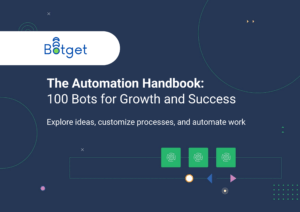Robotic process automation or RPA automation is a type of operating software which allows Bots to be developed to perform certain tasks and processes for us. In the so-called digital transformation, RPA is gaining great importance thanks to the large number of benefits it offers companies.
From an ROI of between 3 to 9 months to a 15% improvement in business growth and productivity, RPA Software is promising. But who can make use of an RPA? Here we tell you which companies can benefit from RPA!

Companies with 50 to 1,000 employees
The first characteristic of the companies that can benefit the most from process automation are those companies that have between 50 and 1,000 employees. These types of companies are in a process of growth and expansion, so productivity and efficiency become essential.
When you don’t have a lot of resources for staffing and not enough staff to cover all the tasks, RPA becomes basic. With RPA you can cover simple to moderately complex tasks and thus free up basic human resources for other projects.
Any business and operating model
Another of the great advantages of robotic process automation (RPA) is the fact that it can be implemented in practically any line of business. From companies dedicated to production to companies focused on services can use it.
And it can be implemented in different areas and departments of a company. The production area with quality controls, finance and accounting with issuance of invoices or sending payments, human resources with payroll management, marketing with data and advertisements, and more! Processes between 15 to 80% complexity can be automated.
Shoestring budget
The cost of RPA software is relatively low compared to the huge savings it generates. Although the acquisition of an RPA can be expensive at first, there are currently subscription models that make the use of an RPA much more accessible.
With this model you do not have to worry about a large initial outlay, but the use of the RPA is divided into affordable payments month by month. Later, you can capitalize to make the payment for the software license, thus helping to have more cash flow.
No programming experience
Especially in small companies, the lack of programmers and IT experts can be a major obstacle to their growth. And in case of having them, developing the IT team or generating the appropriate Know-How can be slow and very expensive.
Developing an IT team for the implementation of in-house process automation will require investment, first of all, in training. You will also need experienced specialists, which is very expensive, and the payment of programming platforms, technological infrastructure, etc. All this will represent a real headache because the road is not easy, especially when the budget is limited and the knowledge is zero.
Rapid expansion
When companies have a sudden success, they often face the dilemma of not knowing how or where to grow. Worse still when resources are limited, as this limits the way they can expand or the resources they can acquire.
RPA automation enables further expansion of operations by freeing up human resources from routine tasks. In addition, process automation makes it possible to expand operational capacity from attending to one task at a time to 10 processes and sub-processes.
Subscription models
As we already told you, now there is the option of accessing an RPA without having to pay the full cost to acquire the software. This is because we can currently find RPA as a Service or RPA as a service.
In this model, you pay a monthly subscription as if it were Netflix, being able to access the benefits of RPA and keeping your cash flow intact. If we compare the cost of acquiring an RPA with the subscription as a service, the cost is a fraction of this which means that companies with limited budgets can access an RPA.
Companies looking to improve their productivity
One of the most common cases in companies with between 50 and 1,000 employees is to come across international clients that require their products or services. Unfortunately, many companies lack the ability to understand this type of customer because their demand is higher.
The lack of employees or their saturation in terms of work can limit the expansion of a company outside its borders. With RPA automation, the need for more employees is reduced, which allows you to improve your productivity to compete globally and better stand out in your niche.
More content to grow your business by automating
Download Automation Manual
Discover 100 ways successful companies have stopped wasting hundreds of hours each year maximizing profit.










